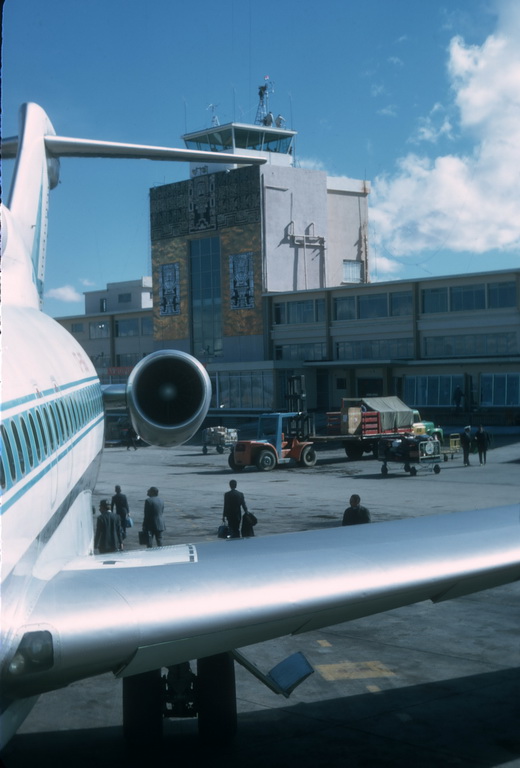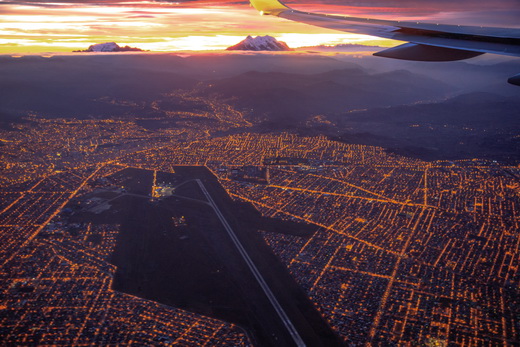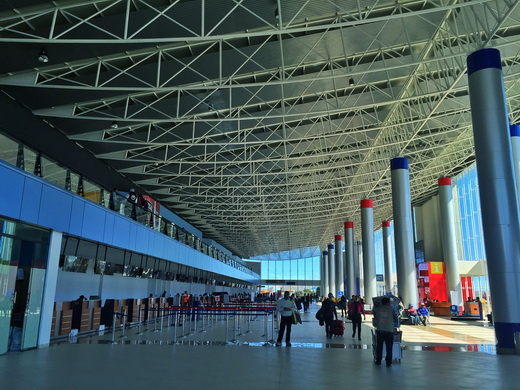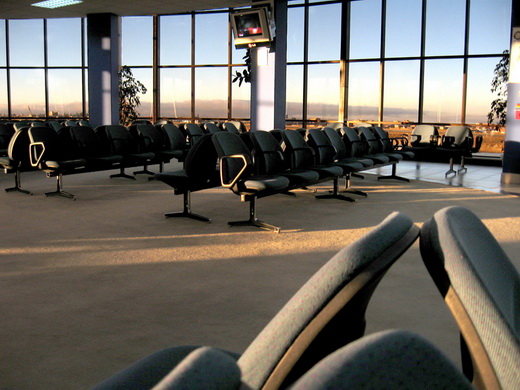 |
|
El Alto International Airport |
El Alto International Airport (Spanish: Aeropuerto Internacional El Alto) (IATA: LPB, ICAO: SLLP) is an international airport serving La Paz, Bolivia. It is located in the city of El Alto, 8 mi (13 km) west of La Paz. At an altitude of 4,061.5 m (13,325 ft), it is the highest international airport and the fifth highest commercial airport in the world.
The airport has been in service since the first half of the 20th century, but was modernized in the late 1960s, when its runway was lengthened and a new passenger terminal with modern facilities was built. The new airport was inaugurated in 1965. El Alto airport was a primary hub for the former Lloyd Aéreo Boliviano, Bolivia’s flag carrier which ceased operations in 2007 and is a hub for Línea Aérea Amaszonas. It serves also as a focus city for Boliviana de Aviación which is a state-owned airline.
|
El Alto International Airport
Aeropuerto Internacional El Alto
|
|
|
- IATA: LPB
- ICAO: SLLP
- WMO: 85201
|
| Summary |
| Airport type |
Public / Military |
| Owner |
Government of Bolivia |
| Operator |
SABSA S.A. |
| Serves |
La Paz, Bolivia |
| Location |
El Alto, Bolivia |
| Hub for |
|
| Focus city for |
|
| Elevation AMSL |
4,061.5 m / 13,325 ft |
| Coordinates |
16°30′48″S
068°11′32″W |
| Website |
www.sabsa.aero |
| Map |
Location of airport in Bolivia
|
| Runways |
| Direction |
Length |
Surface |
| m |
ft |
| 10R/28L |
4,000 |
13,123 |
Asphalt |
| 10L/28R |
2,050 |
6,725 |
Grass |
|
| Statistics (2013) |
|
|
History

The airport during the 1960s. A LAB Boeing 727-100 is seen in the foreground with the old terminal and its iconic Inca façade in the background.
Bolivia is characterized by an extremely varied terrain including rugged mountains, high plateaus, low valleys and tropical forests; this topography has had a negative effect on national transportation, making communication difficult between elevated and low cities along with isolated tropical towns. Aviation is an important solution for isolated communities in this environment.
Bolivian air transport started in 1916, when the Military school of Aviation (Spanish: Escuela Militar de Aviación) was formed in La Paz. In 1929 the local La Paz Government first planned the construction of an airport. However it was not officially inaugurated until the 1960s. In 1974 the airport was reconstructed, a new terminal was built and its facilities were enlarged and modernized. Until 1999 the airport had John F. Kennedy (JFK) as its official name although in practice this name was never publicly used. In that year, before the pressure of different sectors, by means of the Law 1944 during the government of Hugo Banzer Suárez the airport changed its name officially to El Alto International Airport.
Modernization
In 2006, SABSA (Spanish: Servicios Aeroportuarios Bolivianos S.A.) invested nearly 2.3 million dollars in the reconstruction of the main terminal. The new terminal consists of the enlargement, reshaping and construction of the baggage claim room, the check-in area and the corridor to the air bridges. The administrative offices of AASANA as well as the main hall and the international area were completely modernized.
Characteristics

At more than 13,000 ft above sea level, El Alto is one of the highest international airports in the world
The new terminal includes various shops offering Bolivian handicrafts as well as bookstores, and duty-free shops. There are also restaurants and cafes in the main lobby and in both domestic and international departure areas.
The airport has two runways: The main one «10R/28L» has a concrete surface and is 4,000 metres (13,123 ft) long, allowing large aircraft operations at higher altitudes. A second runway, «10L/28R» is located parallel to the main runway and has a grass surface. The airport is equipped with VOR/DME, DVOR/DME navigation systems, as well as ILS CAT I approach systems.
El Alto is the world’s highest international airport, located at 4,062 metres (13,327 ft) above sea level. The average temperature at the airport is 6 °C (43 °F). Because of the thin high altitude air, most commercial wide-body aircraft such as the Boeing 747 and Airbus A330 cannot operate at full load out of El Alto International Airport. As a result, much of the international traffic to and from Bolivia operates out of Viru Viru International Airport in Santa Cruz de la Sierra which is located at a much lower altitude, allowing heavy aircraft operations.
Flight testing
As one of the world’s highest-altitude airports, El Alto offers features taken advantage of by aircraft manufacturers such as Airbus and Boeing to test high-altitude takeoff and landing. Modern aircraft such as the Airbus A350 XWB and Boeing 787 have used El Alto to perform flight tests for their certification processes.
Operators
From 1997, the airport was managed by TBI plc which owned concessions of the three biggest airports in the country: El Alto International Airport, Jorge Wilstermann International Airport and Viru Viru International Airport through its subsidiary Servicio de Aeropuertos Bolivianos S.A. (SABSA). In 1999 Airport Group International was purchased by TBI plc. In 2004, the company was acquired by the Spanish conglomerate Abertis, hence taking ownership of SABSA. In February 2013, the Government of Bolivia announced the nationalization of SABSA, taking full ownership and operations of Bolivia’s main international gateways.
Airlines and destinations

The new terminal is used for both domestic and international flights.

Domestic departures and waiting area in the old terminal.
| Destinations |
| Amaszonas |
Iquique, Rurrenabaque, Santa Cruz de la Sierra–Viru Viru, Uyuni
Seasonal: Cuzco |
| Avianca |
Bogotá, Washington-Dulles1 |
| Avianca Ecuador |
Guayaquil2, Lima |
| Boliviana de Aviación |
Cobija, Cochabamba, Potosí, Santa Cruz de la Sierra–Viru Viru, Sucre, Trinidad, Tarija, Uyuni |
| EcoJet |
Cobija, Guayaramerín, Riberalta, Trinidad, Cochabamba |
| LATAM Chile |
Santiago de Chile |
| LATAM Perú |
Cuzco, Lima |
Notes:
- ^1 : Avianca’s flight to Washington, D.C. makes a stop in Bogotá.
- ^2 : Avianca’s flight to Guayaquil makes a stop in Lima.
Accidents and incidents
- On 14 July 1970, Douglas DC-3 TAM-17 of TAM – Transporte Aéreo Militar was damaged beyond repair in an accident.
- On 4 May 1971, Douglas C-47 TAM-22 of TAM – Transporte Aéreo Militar crashed shortly after take-off on a cargo flight to El Jovi Airport.
- On 17 September 1972, Douglas C-47A CP-565 of Aerolíneas Abaroa crashed on take-off. The aircraft was operating a non-scheduled passenger flight. All four people on board survived.
- On 25 November 1976, Douglas C-47 CP-755 of Aerolíneas La Paz was damaged beyond economic repair in a landing accident. The aircraft was on a cargo flight, all four people on board survived.
- On 1 January 1985, Eastern Air Lines Flight 980 from Asuncion hit Mount Illimani during its descent towards El Alto, killing all 29 people on board the Boeing 727-225; the flight was scheduled to continue to Lima, Guayaquil, Panama City, Miami, and Chicago.
The above content comes from Wikipedia and is published under free licenses – click here to read more.
| General Info
|
| Country |
Bolivia
|
| ICAO ID |
SLLP
|
| Time |
UTC-4
|
| Latitude |
-16.513339
16° 30' 48.02" S
|
| Longitude |
-68.192256
068° 11' 32.12" W
|
| Elevation |
13325 feet
4061 meters
|
| Type |
Joint (Civil and Military)
|
| Magnetic Variation |
005° W (05/06)
|
| Beacon |
Yes
|
| Operating Agency |
MILITARY - CIVIL JOINT USE AIRPORT
|
| Near City |
La Paz
|
| Operating Hours |
24 HOUR OPERATIONS
|
| International Clearance Status |
Airport of Entry
|
| Communications
|
| LA PAZ TWR |
118.3
|
| LA PAZ RDO |
6622
4669
6649
10024
3479
|
| LA PAZ FIS |
127.1
|
| GND |
121.9
|
| LA PAZ APP |
119.5
|
| Runways
|
| ID |
Dimensions |
Surface |
PCN |
ILS
|
| 10/28 |
13123 x 151 feet
4000 x 46 meters |
CONCRETE. |
046RAXU |
YES
|
| 10L/28R |
6725 x 300 feet
2050 x 91 meters |
GRADED OR ROLLED EARTH, GRASS ON GRADED EARTH. |
- |
NO
|
| Navaids
|
| Type |
ID |
Name |
Channel |
Freq |
Distance From Field |
Bearing From Navaid
|
| VOR-DME |
PAZ |
LA PAZ |
104X |
115.7 |
2.4 NM |
097.4
|
| NDB |
LPZ |
LA PAZ |
- |
350 |
1.4 NM |
261.8
|
| Supplies/Equipment
|
| Fuel |
Jet A, without icing inhibitor.
100/130 MIL Spec, low lead, aviation gasoline (BLUE)
|
| Remarks
|
| CAUTION |
Nml opr are opposite drct tfc, with Rwy 28 for dep and Rwy 10 for arr. Exercise extreme caution due VFR-IFR acft holding/climbing over the VOR and SW of the afld. Use caution when taxiing to mil ramp via circular twy connecting trml ramp with EARTH Rwy 10L-28R. Caution rqr due to a metal fence and several small conc shacks wi 25 ft of C17/C141/KC10 wing tip. Deplaning scanners rqr.
|
| FUEL |
A1 (Air BP via Combraero C591-2-281-0240) (NC-100LL)
|
| LGT |
PAPI Rwy 10 GS 2.4 MEHT 69'. PAPI Rwy 28 MEHT 65'.
|
| MISC |
Wx.
|
| RSTD |
Convl acft proh tkof Rwy 10. Earth Rwy 10L-28R for emerg use only by convl acft.
|
The content above was published at Airports-Worldwide.com in 2019.
We don't guarantee the information is fresh and accurate. The data may be wrong or outdated.
For more up-to-date information please refer to other sources.
|
 |



